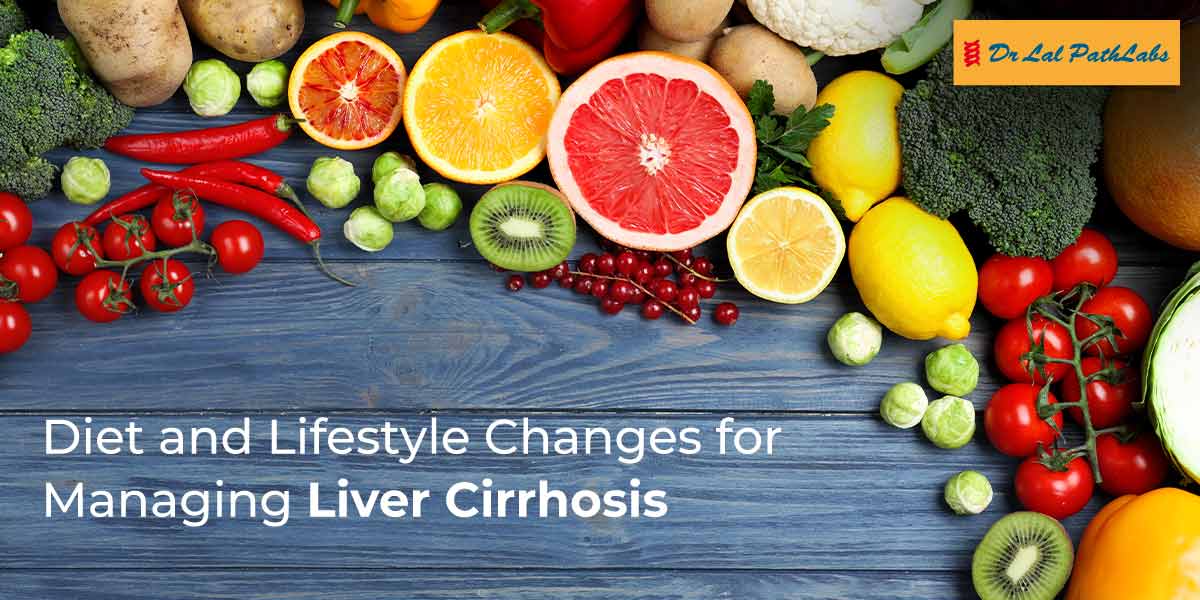Diet and Lifestyle Changes for Managing Liver Cirrhosis
- 8 Jan, 2025
- Written by Team Dr Lal PathLabs
Medically Approved by Dr. Seema
Table of Contents

The liver is responsible for more than 500 vital functions, including producing proteins, fighting infections, detoxifying the blood, aiding in digestion, and storing energy. When the liver doesn’t function correctly, it can lead to serious health issues, affecting everything from metabolism to immune response.
With over 1.5 billion cases worldwide, liver cirrhosis is one of the most complex forms of liver disease, as it severely compromises liver function. Several conditions cause liver scarring or cirrhosis. Identifying and treating these conditions early and implementing dietary and lifestyle changes is the only way to manage liver cirrhosis.
This blog examines early intervention strategies, dietary modifications, and lifestyle changes essential for effectively managing liver cirrhosis.
Liver Cirrhosis: What is it?
Liver cirrhosis is a condition that causes scarring of the liver as a result of a chronic injury or disease. It is also known as hepatic cirrhosis. The scarring results in the formation of fibrous collagen tissue, preventing blood and oxygen from passing through the liver, thus impairing its functioning.
Liver damage that is caused by cirrhosis cannot be reversed, however, with proper management it can be prevented from worsening.
What Are the Causes of Liver Cirrhosis?
Liver cirrhosis can develop from various diseases and conditions that gradually damage the liver. Here are the main contributors:
- Long-term Alcohol Consumption: Alcohol consumption over an extended period of time damages and inflames the liver, which leads to scarring.
- Poor Diet: Saturated fats and sugar-rich diets have been associated with conditions like nonalcoholic fatty liver disease (NAFLD). This fat buildup in the liver can result in inflammation and cirrhosis.
- Genetic Disorders: Wilson disease, cystic fibrosis, and glycogen storage disease are a few hereditary disorders that may cause the liver to get damaged by the buildup of harmful compounds.
- Autoimmune Conditions: A number of autoimmune conditions, such as autoimmune hepatitis, primary biliary cholangitis, and primary sclerosing cholangitis, can result in persistent inflammation of the liver.
- Infections: Liver inflammation that persists over time can be caused by chronic infections, including hepatitis B and C.
What Are the Benefits of the Cirrhosis Diet?
A well-balanced diet plan for liver cirrhosis patients promotes optimal nutrition and alleviates the liver’s workload. Given that the most common causes of liver cirrhosis include long-term alcohol consumption and a diet high in fats, making dietary changes can have significant benefits. A few benefits are as follows:
- It helps prevent additional liver damage by avoiding foods that strain the liver.
- A well-balanced diet can help prevent issues like fluid buildup, muscle loss, and nutritional deficiencies.
- Proper nutrition supports overall health, improving outcomes for individuals with cirrhosis.
What Is the Relationship Between Cirrhosis and Diet?
1. Caloric and Protein Intake:
People with cirrhosis must consume enough calories and protein to maintain overall health and avoid muscle loss.
●Animal-Based: Eggs, low-fat dairy products, lean cuts of meat (chicken, turkey), and seafood.
● Plant-Based: Legumes (beans, lentils, chickpeas), nuts (walnuts, almonds, cashews), and seeds (pumpkin seeds, chia seeds).
2. Limit Unhealthy Foods:
Restrict foods and drinks that are hard for the liver to process. This includes:
● Unhealthy Fats: Avoid fried foods, processed snacks, and products high in trans fats (e.g., margarine, vegetable shortening).
● Alcohol: Completely eliminate alcohol, as it worsens liver damage.
● Raw or Undercooked Foods: Stay away from raw or undercooked meat, eggs, and seafood to reduce the risk of foodborne illnesses.
3. Monitor Vitamin and Mineral Intake:
Individuals with cirrhosis may require additional nutrients, such as zinc, vitamin D, vitamin K, and B vitamins. Consult the doctor for specific supplement recommendations and include foods like:
● Zinc: Oysters, Pumpkin seeds
● Vitamin D: Fatty fish (e.g., salmon), Egg yolks
● Vitamin K: Kale. Broccoli
● B Vitamins: Legumes (e.g., lentils), chicken
Managing liver cirrhosis starts with early intervention, dietary adjustments, lifestyle changes, and timely treatment. Regular health checkups play a key role, as many individuals may not experience symptoms initially.
To diagnose liver cirrhosis, consult with a doctor early and book a liver test with Dr Lal PathLabs today!
FAQS
1. Is liver cirrhosis treatment effective?
Liver cirrhosis cannot be reversed as the scarring is permanent. Careful management of complications, dietary and lifestyle modifications, and treatment of the underlying cause can all help to delay or reverse the disease’s progression.
2. What is the best food for liver cirrhosis?
A well-planned cirrhosis diet should include nutrient-dense foods that are high in heart-healthy fats, lean proteins, whole grains, and fruits and vegetables.
3. What are the foods that should be avoided?
If someone has liver cirrhosis, foods to avoid include alcoholic beverages, processed foods, trans fats, refined sugars, etc, as these can lead to further complications.














